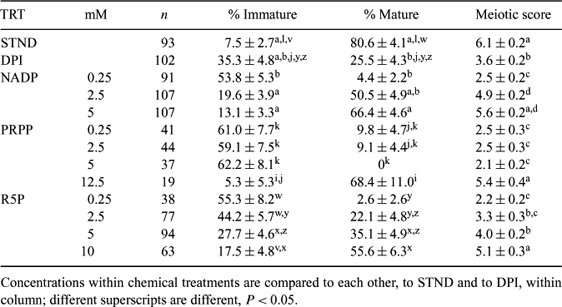287 INHIBITION OF THE PENTOSE PHOSPHATE PATHWAY RESULTS IN MEIOTIC ARREST IN PORCINE OOCYTES THAT CAN BE OVERCOME BY THE ADDITION OF PATHWAY COFACTORS AND END PRODUCTS
R. KrisherDepartment of Animal Sciences, Purdue University, West Lafayette, IN 47907, USA. Email: rkrisher@purdue.edu
Reproduction, Fertility and Development 17(2) 293-294 https://doi.org/10.1071/RDv17n2Ab287
Submitted: 1 August 2004 Accepted: 1 October 2004 Published: 1 January 2005
Abstract
Glucose metabolism is an indicator of oocyte developmental competence, and is also correlated with meiotic maturation. In vitro maturation of porcine oocytes with the pentose phosphate pathway (PPP) inhibitor diphenyleneiodonium (DPI) blocks meiotic progression to metaphase II. The objectives of this study were (1) to examine the reversibility of meiotic arrest induced by DPI; and (2) to overcome metabolically induced meiotic arrest by the addition of PPP end products and cofactors downstream of DPI inhibition. Oocytes were matured for 40 h in standard (defined) maturation media containing 0, 25, 50, or 100 nM DPI. At that time half the oocytes in each treatment (TRT) were fixed, and half were moved into standard maturation medium with no DPI for an additional 40 h, at which time all remaining oocytes were fixed. Two oocytes were matured for 40 h in one of 11 media: standard (defined) maturation medium (STND), standard with 50 nM DPI (DPI), standard with 50 nM DPI and 0.25, 2.5, or 5 mM phosphoribose diphosphate (PRPP), nicotinamide adenine dinucleotide phosphate (NADP), or ribose-5-phosphate (R5P). Additionally, 10 mM R5P and 12.5 mM PRPP were examined. All oocytes were fixed. Oocytes were assigned a meiotic score; germinal vesicle (GV) = 1, GV breakdown (GVBD) = 2, condensed chromatin (CC) = 3, metaphase I (MI) = 4, anaphase (A) = 5, telophase (T) = 6, and metaphase II (MII) = 7. Immature oocytes were classified as those at GV or GVBD stages, and mature oocytes as those at A, T or MII stages. Data were analyzed by ANOVA and are presented as mean ± SEM. After 40 h of arrest (n = 79–87/TRT), increasing concentrations of DPI significantly increased the % of immature oocytes (0, 7.2 ± 2.9; 25, 26.4 ± 4.8; 50, 53.2 ± 5.7; 100, 75.9 ± 4.8) and decreased the % of mature oocytes (0, 73.5 ± 4.9; 25, 52.9 ± 5.4; 50, 20.3 ± 4.6; 100, 0). After an additional 40 hours in standard maturation medium (n = 89–93/TRT), there was no difference in the % of immature oocytes between treatments (0, 7.5 ± 2.8; 25, 14.4 ± 3.7; 50, 13.0 ± 3.5; 100, 9.0 ± 3.0) although the % of mature oocytes significantly decreased with increasing DPI concentration (0, 90.3 ± 3.1; 25, 68.9 ± 4.9; 50, 35.9 ± 5.0; 100, 10.1 ± 3.2). Data from experiment 2 are presented below. Meiotic maturation is significantly inhibited by DPI in a dose-dependent manner. Ability of the oocyte to reach MII following 40 h of arrest is also concentration-dependent, although all treatments resulted in GVBD following removal from DPI. Metabolic arrest can be overcome, resulting in numbers of mature oocytes equal to standard controls, by NADP and PRPP but only moderately by R5P. These data demonstrate that glucose metabolism via the PPP is a critical control mechanism of meiotic maturation in porcine oocytes.

|


